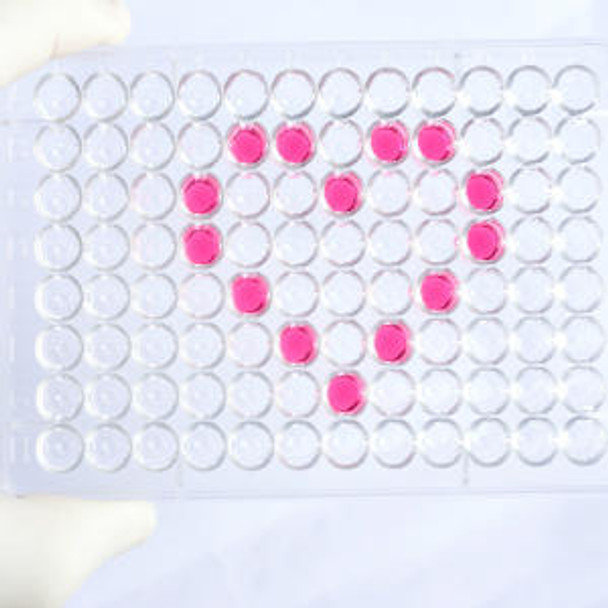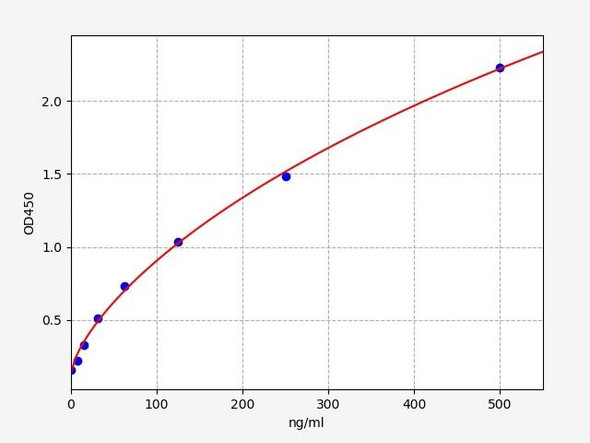Human Apolipoprotein C-III (APOC3) ELISA Kit
- SKU:
- HUEB0293
- Product Type:
- ELISA Kit
- Size:
- 96 Assays
- Uniprot:
- P02656
- Range:
- 2.35-150 ng/mL
- ELISA Type:
- Sandwich
- Synonyms:
- ApoC3, Apolipoprotein C3, APOC3, ApoC-III, MGC150353, Apo-CIII, APOCIII, apoC-III
- Reactivity:
- Human
Description
Human Apolipoprotein C-III (APOC3) ELISA Kit
Key Features
| Save Time | Pre-coated 96 well plate | |
| Quick Start | Kit includes all necessary reagents | |
| Publication Ready | Reproducible and reliable results |
Overview
|
Product Name: |
Human Apolipoprotein C-III (APOC3) ELISA Kit |
|
Product Code: |
HUEB0293 |
|
Size: |
96 Assays |
|
Alias: |
Apolipoprotein C-III, Apo-CIII, ApoC-III, Apolipoprotein C3, APOC3 |
|
Detection Method: |
Sandwich |
|
Reactivity: |
Human |
|
Range: |
2.35-150 ng/mL |
|
Storage: |
4°C for 6 months |
|
Note: |
For Research Use Only |
Protein Information
|
Uniprot: |
P02656 |
|
UniProt Protein Function: |
APOC3: Inhibits lipoprotein lipase and hepatic lipase and decreases the uptake of lymph chylomicrons by hepatic cells. This suggests that it delays the catabolism of triglyceride-rich particles. Defects in APOC3 are the cause of hyperalphalipoproteinemia type 2 (HALP2). HALP2 is a condition characterized by high levels of high density lipoprotein (HDL) and increased HDL cholesterol levels. Belongs to the apolipoprotein C3 family. |
|
UniProt Code: |
|
|
NCBI GenInfo Identifier: |
|
|
NCBI Gene ID: |
|
|
NCBI Accession: |
|
|
UniProt Related Accession: |
|
|
Molecular Weight: |
10,852 Da |
Kit Components
| Component | Quantity | Storage |
|
ELISA Microplate (Dismountable) |
8x12 strips |
-20°C |
|
Lyophilized Standard |
2 |
-20°C |
|
Sample Diluent |
20ml |
-20°C |
|
Assay Diluent A |
10mL |
-20°C |
|
Assay Diluent B |
10ml |
-20°C |
|
Detection Reagent A |
60µL |
-20°C |
|
Detection Reagent B |
120µL |
-20°C |
|
Wash Buffer (25X) |
30ml |
4°C |
|
Substrate |
10mL |
4°C |
|
Stop Solution |
10ml |
4°C |
|
Plate Sealer |
5 |
- |
Other materials required:
- Microplate reader with 450 nm wavelength filter
- Multichannel Pipette, Pipette, microcentrifuge tubes and disposable pipette tips
- Incubator
- Deionized or distilled water
- Absorbent paper
- Buffer resevoir
Protocol
*Note: Protocols are specific to each batch/lot. For the exact instructions please follow the protocol included in your kit.
Before adding to wells, equilibrate the SABC working solution and TMB substrate for at least 30 min at 37°C. When diluting samples and reagents, they must be mixed completely and evenly. It is recommended to plot a standard curve for each test.
| Step | Procedure |
|
1. |
Set standard, test sample and control (zero) wells on the pre-coated plate respectively, and then, record their positions. It is recommended to measure each standard and sample in duplicate. Wash plate 2 times before adding standard, sample and control (zero) wells! |
|
2. |
Aliquot 0.1ml standard solutions into the standard wells. |
|
3. |
Add 0.1 ml of Sample / Standard dilution buffer into the control (zero) well. |
|
4. |
Add 0.1 ml of properly diluted sample ( Human serum, plasma, tissue homogenates and other biological fluids.) into test sample wells. |
|
5. |
Seal the plate with a cover and incubate at 37 °C for 90 min. |
|
6. |
Remove the cover and discard the plate content, clap the plate on the absorbent filter papers or other absorbent material. Do NOT let the wells completely dry at any time. Wash plate X2. |
|
7. |
Add 0.1 ml of Biotin- detection antibody working solution into the above wells (standard, test sample & zero wells). Add the solution at the bottom of each well without touching the side wall. |
|
8. |
Seal the plate with a cover and incubate at 37°C for 60 min. |
|
9. |
Remove the cover, and wash plate 3 times with Wash buffer. Let wash buffer rest in wells for 1 min between each wash. |
|
10. |
Add 0.1 ml of SABC working solution into each well, cover the plate and incubate at 37°C for 30 min. |
|
11. |
Remove the cover and wash plate 5 times with Wash buffer, and each time let the wash buffer stay in the wells for 1-2 min. |
|
12. |
Add 90 µl of TMB substrate into each well, cover the plate and incubate at 37°C in dark within 10-20 min. (Note: This incubation time is for reference use only, the optimal time should be determined by end user.) And the shades of blue can be seen in the first 3-4 wells (with most concentrated standard solutions), the other wells show no obvious color. |
|
13. |
Add 50 µl of Stop solution into each well and mix thoroughly. The color changes into yellow immediately. |
|
14. |
Read the O.D. absorbance at 450 nm in a microplate reader immediately after adding the stop solution. |
Sample Type
When carrying out an ELISA assay it is important to prepare your samples in order to achieve the best possible results. Below we have a list of procedures for the preparation of samples for different sample types.
| Sample Type | Protocol |
|
Serum |
If using serum separator tubes, allow samples to clot for 30 minutes at room temperature. Centrifuge for 10 minutes at 1,000x g. Collect the serum fraction and assay promptly or aliquot and store the samples at -80°C. Avoid multiple freeze-thaw cycles. If serum separator tubes are not being used, allow samples to clot overnight at 2-8°C. Centrifuge for 10 minutes at 1,000x g. Remove serum and assay promptly or aliquot and store the samples at -80°C. Avoid multiple freeze-thaw cycles. |
|
Plasma |
Collect plasma using EDTA or heparin as an anticoagulant. Centrifuge samples at 4°C for 15 mins at 1000 × g within 30 mins of collection. Collect the plasma fraction and assay promptly or aliquot and store the samples at -80°C. Avoid multiple freeze-thaw cycles. Note: Over haemolysed samples are not suitable for use with this kit. |
|
Urine & Cerebrospinal Fluid |
Collect the urine (mid-stream) in a sterile container, centrifuge for 20 mins at 2000-3000 rpm. Remove supernatant and assay immediately. If any precipitation is detected, repeat the centrifugation step. A similar protocol can be used for cerebrospinal fluid. |
|
Cell culture supernatant |
Collect the cell culture media by pipette, followed by centrifugation at 4°C for 20 mins at 1500 rpm. Collect the clear supernatant and assay immediately. |
|
Cell lysates |
Solubilize cells in lysis buffer and allow to sit on ice for 30 minutes. Centrifuge tubes at 14,000 x g for 5 minutes to remove insoluble material. Aliquot the supernatant into a new tube and discard the remaining whole cell extract. Quantify total protein concentration using a total protein assay. Assay immediately or aliquot and store at ≤ -20 °C. |
|
Tissue homogenates |
The preparation of tissue homogenates will vary depending upon tissue type. Rinse tissue with 1X PBS to remove excess blood & homogenize in 20ml of 1X PBS (including protease inhibitors) and store overnight at ≤ -20°C. Two freeze-thaw cycles are required to break the cell membranes. To further disrupt the cell membranes you can sonicate the samples. Centrifuge homogenates for 5 mins at 5000xg. Remove the supernatant and assay immediately or aliquot and store at -20°C or -80°C. |
|
Tissue lysates |
Rinse tissue with PBS, cut into 1-2 mm pieces, and homogenize with a tissue homogenizer in PBS. Add an equal volume of RIPA buffer containing protease inhibitors and lyse tissues at room temperature for 30 minutes with gentle agitation. Centrifuge to remove debris. Quantify total protein concentration using a total protein assay. Assay immediately or aliquot and store at ≤ -20 °C |
|
Breast Milk |
Collect milk samples and centrifuge at 10,000 x g for 60 min at 4°C. Aliquot the supernatant and assay. For long term use, store samples at -80°C. Minimize freeze/thaw cycles. |
APOC3 Background
Human Apolipoprotein C-III (APOC3) is a protein that plays a significant role in lipid metabolism and has been associated with cardiovascular diseases, particularly hypertriglyceridemia. APOC3 is primarily produced in the liver and is involved in regulating triglyceride-rich lipoproteins, such as very low-density lipoproteins (VLDLs).
APOC3 Function
The primary function of APOC3 is the regulation of triglyceride metabolism. It inhibits the activity of lipoprotein lipase (LPL), an enzyme responsible for the breakdown of triglycerides. By inhibiting LPL, APOC3 reduces the clearance of triglyceride-rich lipoproteins from circulation, leading to elevated triglyceride levels.
APOC3 in Cardiovascular Diseases
Elevated levels of APOC3 have been linked to an increased risk of cardiovascular diseases, including atherosclerosis and coronary artery disease. APOC3 inhibits the uptake and clearance of triglyceride-rich lipoproteins, leading to their accumulation in the bloodstream. This dysregulation of lipid metabolism contributes to the development of a proatherogenic lipid profile, promoting the formation of atherosclerotic plaques and increasing the risk of cardiovascular events.
APOC3 FAQs
What is the APOC3 ELISA Kit?
The Human Apolipoprotein C-III (APOC3) ELISA Kit is a specialized assay designed for the detection and quantification of Human APOC3 in biological samples.
What are the advantages of using the APOC3 ELISA Kit?
The Human Apolipoprotein C-III (APOC3) ELISA Kit offers several advantages, including high specificity and sensitivity, ensuring precise measurement of APOC3 levels in biological samples. The kit provides a user-friendly and efficient workflow, delivering rapid and reproducible results.
Where can I find more information about the APOC3 ELISA Kit?
For more detailed information about the APOC3 ELISA Kit, including technical specifications, performance characteristics, and ordering details, please refer to the product brochure or contact our customer support team. We are here to assist you with any inquiries you may have.






